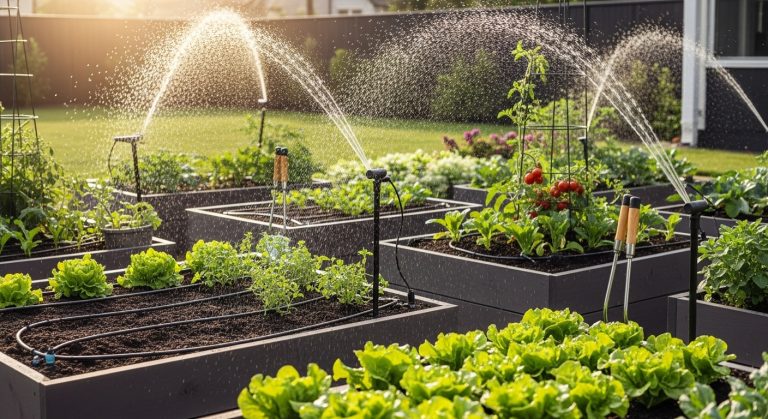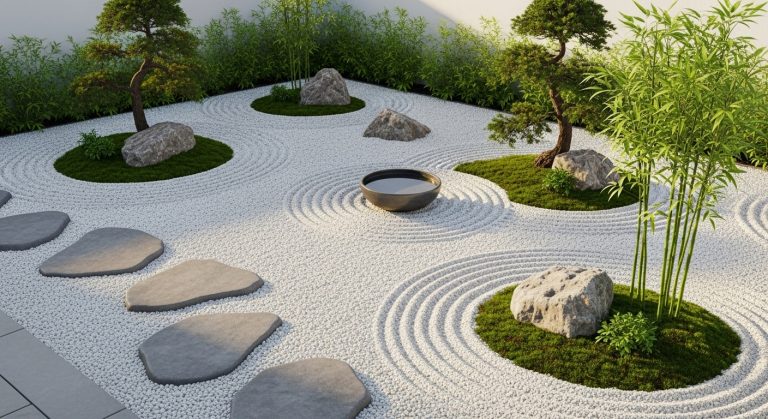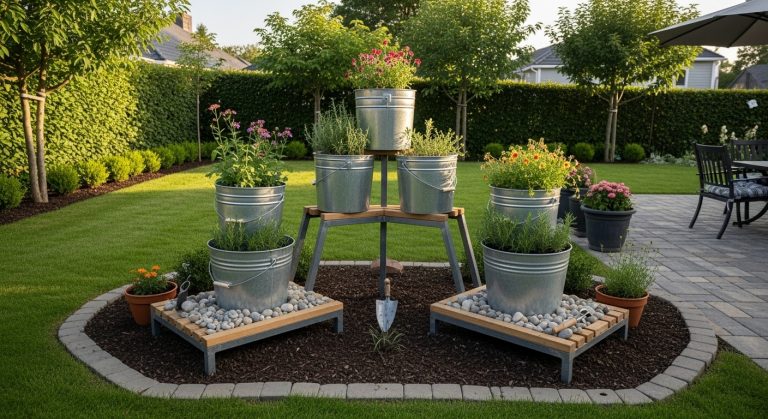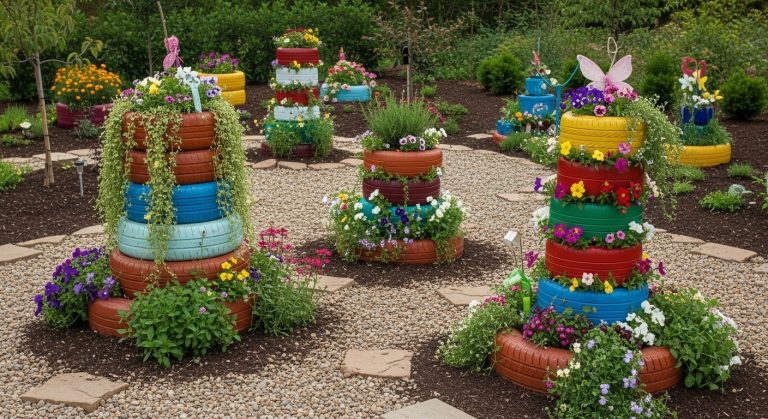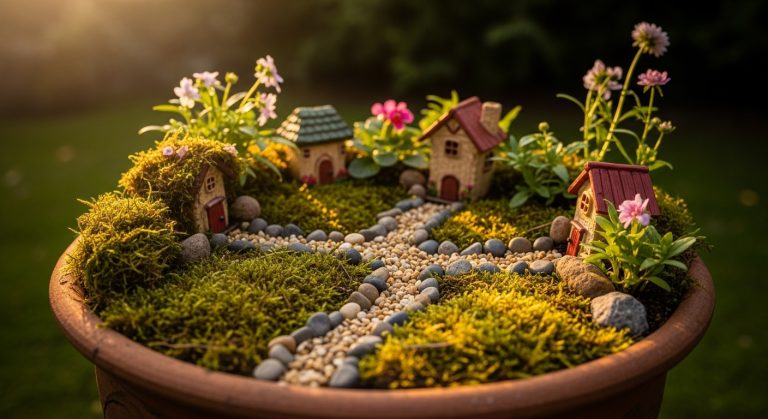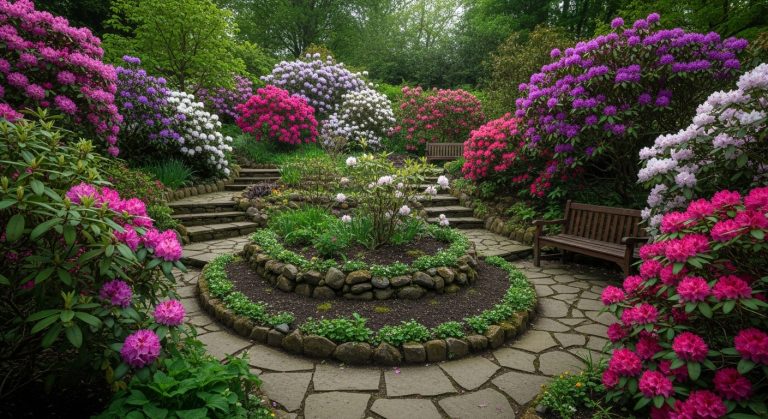Fairy Garden Ideas: 15 Magical Ways to Create Your Own Miniature Wonderland
Ever walk past a patch of your garden and think, “Hmm, this could really use a little magic”? That’s where fairy gardens come in. These whimsical little worlds are more than just miniature decorations — they’re a creative outlet, a conversation starter, and honestly, a chance to let your inner kid run wild (without anyone judging you).
In this guide, I’m sharing 15 detailed fairy garden ideas, each broken down with pros and cons, and all wrapped in a friendly, conversational tone. Whether you’re building one in a teacup, a tree stump, or even an old birdbath, these setups turn your outdoor space into something enchanting.
Ready to sprinkle a little fairy dust? ✨ Let’s get into it.
1. Fairy Garden in a Teacup
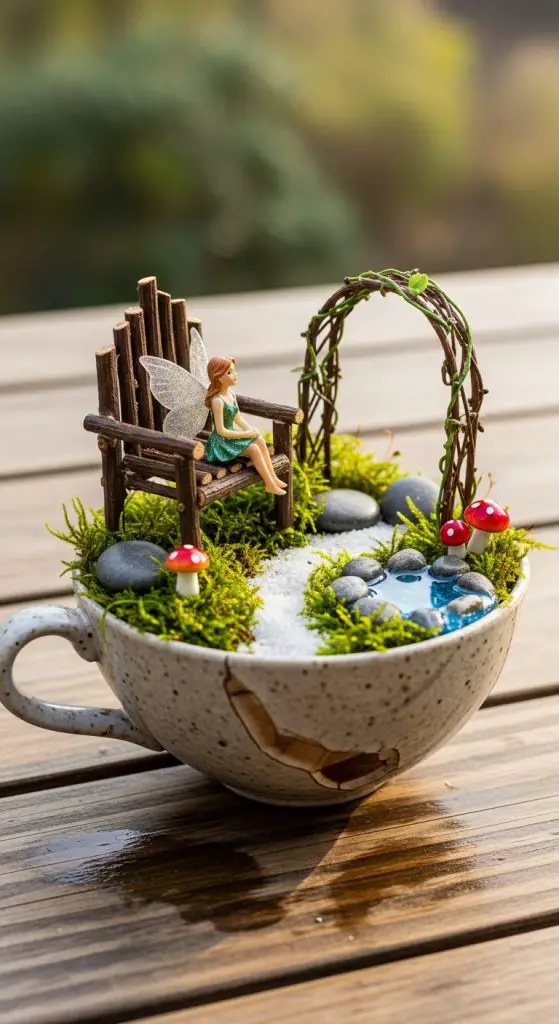
Tiny, portable, and ridiculously charming, a fairy garden in a teacup is the definition of whimsy. It’s basically a little story captured in a single cup — you can tuck in miniature furniture, moss, pebbles, and even a fairy figurine or two. Because it’s so small, you can put it on a kitchen windowsill, office desk, or a shaded corner of your patio.
This kind of fairy garden answers the Google-snippet question perfectly: it’s a miniature garden crafted inside a teacup, often using moss, succulents, and fairy-themed miniatures.
Ever wanted to create magic in less than six inches of space? This is your chance. Plus, you don’t need to be a gardening expert — anyone can do this with a steady hand and some imagination.
Pros:
- Compact and portable — fits almost anywhere.
- Super budget-friendly (you probably already have an old teacup).
- Great for gifting — imagine handing someone a cup of magic.
Cons:
- Limited plant variety due to small space.
- Needs regular watering checks since soil dries quickly.
2. Fairy Garden in a Tree Stump
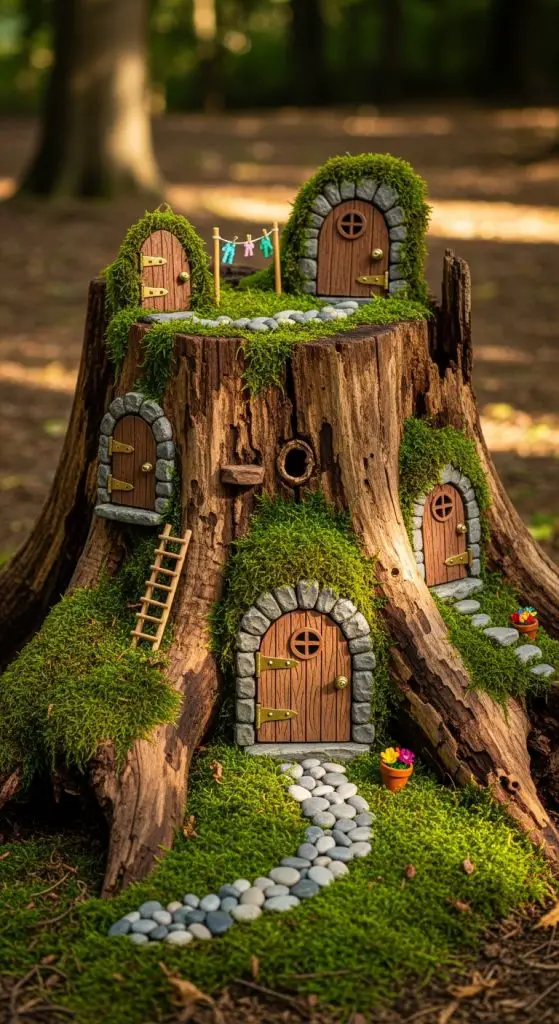
Got an old tree stump in your yard that’s just… there? Instead of glaring at it, transform it into a fairy garden in a tree stump. This setup makes it look like the fairies carved out their own woodland home. You can hollow out the stump slightly, add soil, moss, and tiny fairy doors, then surround it with mini pathways made from pebbles.
According to a Houzz landscaping survey, repurposed natural features like logs and stumps are trending in backyard designs. Why not hop on that trend with a fairy twist?
It’s rustic, charming, and makes great use of something that might otherwise be considered yard waste. And admit it — the idea of a fairy living in an old stump just feels right.
Pros:
- Eco-friendly use of existing yard features.
- Large enough to allow for more creative layouts.
- Creates a magical focal point in your garden.
Cons:
- Tree stumps can rot over time (:/).
- Attracts bugs if not treated properly.
3. Fairy Garden in a Birdbath
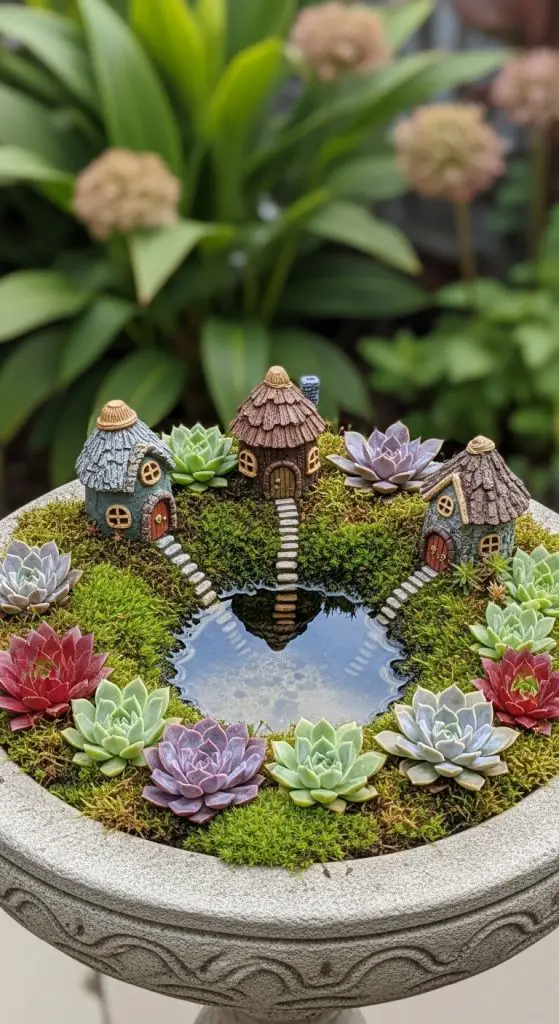
That old, cracked birdbath? Don’t toss it. Turn it into a fairy garden centerpiece. Birdbaths have the perfect shallow bowl shape to house soil, moss, succulents, and fairy accessories. Plus, being elevated, it immediately draws the eye.
This design looks particularly good near patios or porches because the raised height makes the details easy to admire. It also saves you from bending over every time you want to rearrange something (trust me, your back will thank you).
Pros:
- Elevated for easy visibility.
- Repurposes old garden décor.
- Perfect conversation starter for guests.
Cons:
- Limited root space for plants.
- May need drainage fixes if your birdbath doesn’t have holes.
4. Fairy Garden with Succulents
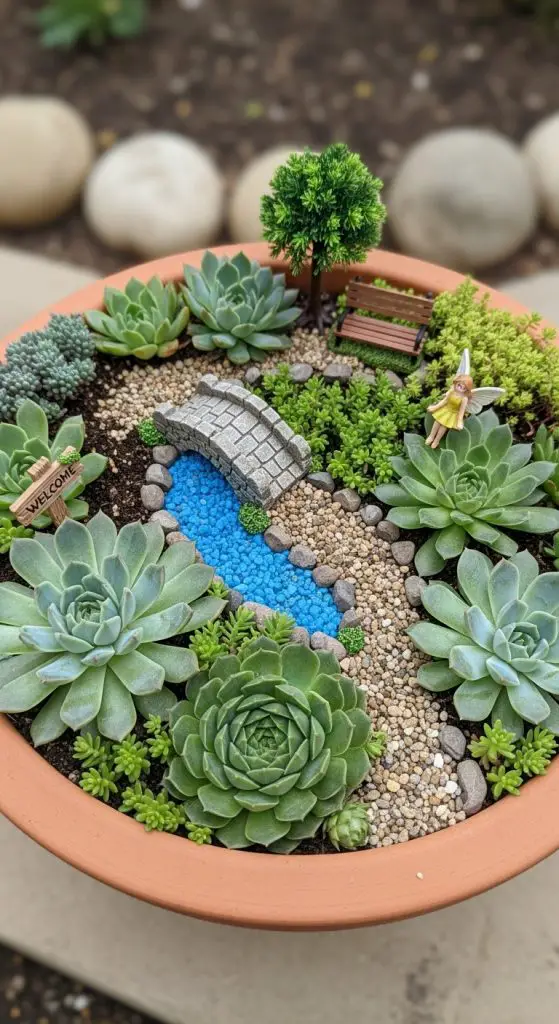
Succulents are practically the MVP of low-maintenance gardening, so why not use them in a succulent fairy garden? Their quirky shapes mimic magical plants you’d expect to find in a fairy world. Think tiny aloe rosettes as “fairy shrubs” or string-of-pearls vines as cascading fairy vines.
Fun fact: According to Statista, the U.S. succulent market was valued at over $2.5 billion in 2022. People love these little guys — and with good reason.
Pair succulents with gravel pathways, small fairy houses, and maybe even a tiny bridge, and you’ve got yourself a fairy garden that’s cute and practical.
Pros:
- Very low maintenance (yay lazy gardeners).
- Works indoors or outdoors.
- Endless design flexibility.
Cons:
- Needs lots of sunlight.
- Not as lush-looking as moss-based fairy gardens.
5. Fairy Garden in a Wagon
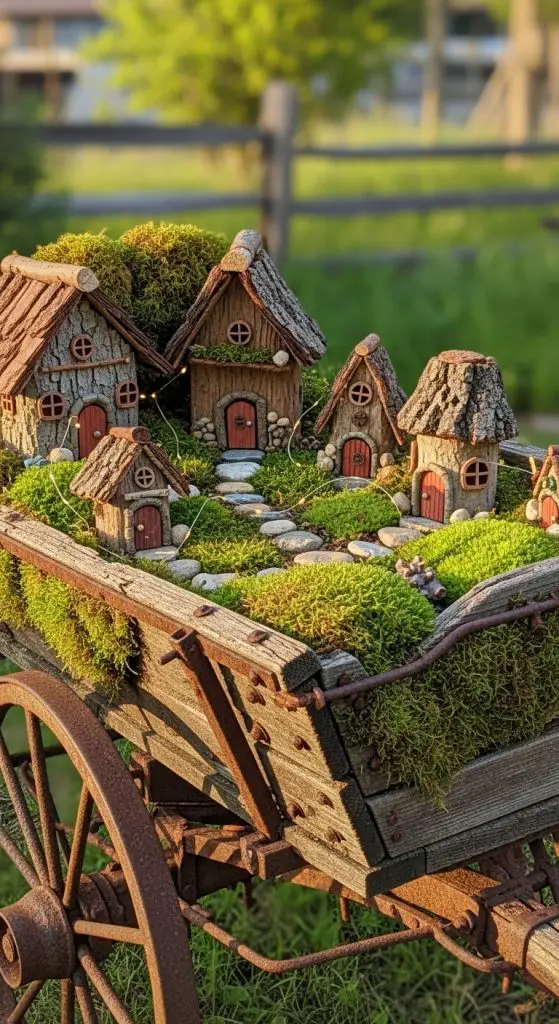
An old red wagon can easily become a rolling fairy garden. Just imagine: soil, moss, fairy houses, tiny fences, all arranged neatly inside a wagon you can move around. Instant portability.
This is great if you want to change your fairy garden’s location based on seasons or events. Hosting a barbecue? Roll it out as a centerpiece. Want to protect it from frost? Wheel it into the garage. Easy peasy.
Pros:
- Portable and fun to move around.
- Reuses old items creatively.
- Plenty of space for detailed setups.
Cons:
- Wagons may rust over time outdoors.
- Can get heavy when filled with soil.
6. Fairy Garden in a Planter Box
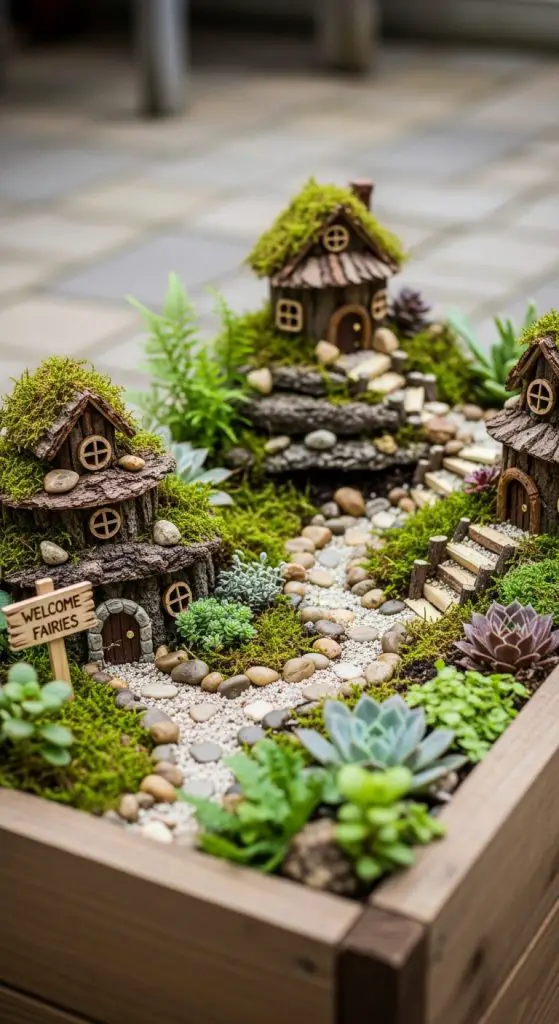
A planter box fairy garden offers more space than a teacup or birdbath, letting you really stretch your creative muscles. Think layered levels, multiple fairy houses, even a small pond made from a shallow dish.
Because planter boxes are elevated, they’re great for kids (no crouching necessary). You can also line them up on balconies or patios for an enchanting row of fairy landscapes.
Pros:
- Larger space = more creativity.
- Easy to maintain at waist height.
- Great for apartment balconies.
Cons:
- Takes up more space.
- Can dry out quickly in full sun.
7. Fairy Garden in a Hanging Basket
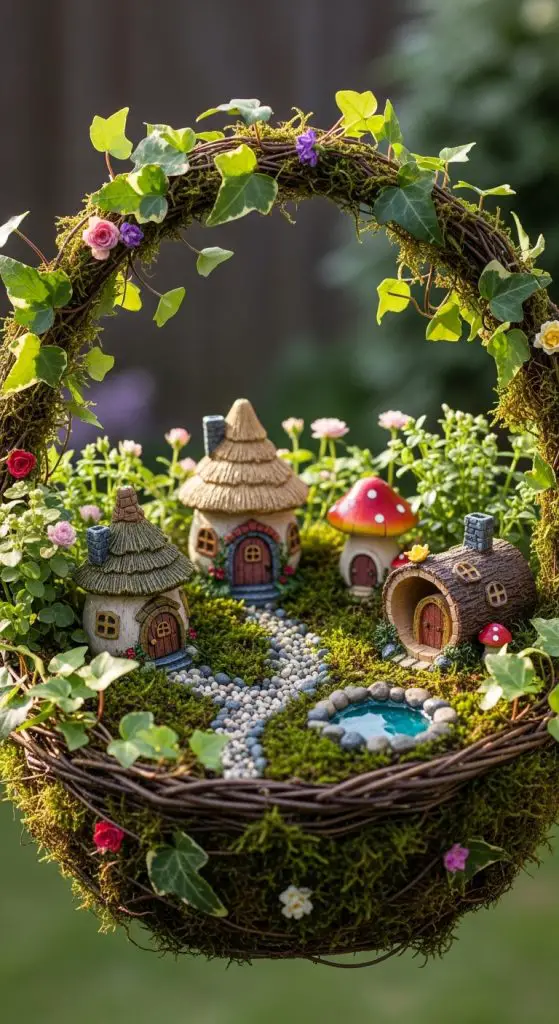
Want your fairies to live in the sky? A hanging basket fairy garden is like a magical floating world. Use trailing plants like ivy or creeping Jenny to make it look lush and overflowing. Tuck fairy houses among the greenery, and you’ve basically created a sky village.
It’s perfect if you’re short on ground space but still want the enchantment of a fairy garden.
Pros:
- Saves ground space.
- Eye-catching, especially with trailing plants.
- Portable and easy to hang anywhere.
Cons:
- Dries out quickly in summer heat.
- Limited weight capacity.
8. Fairy Garden Around a Tree Base
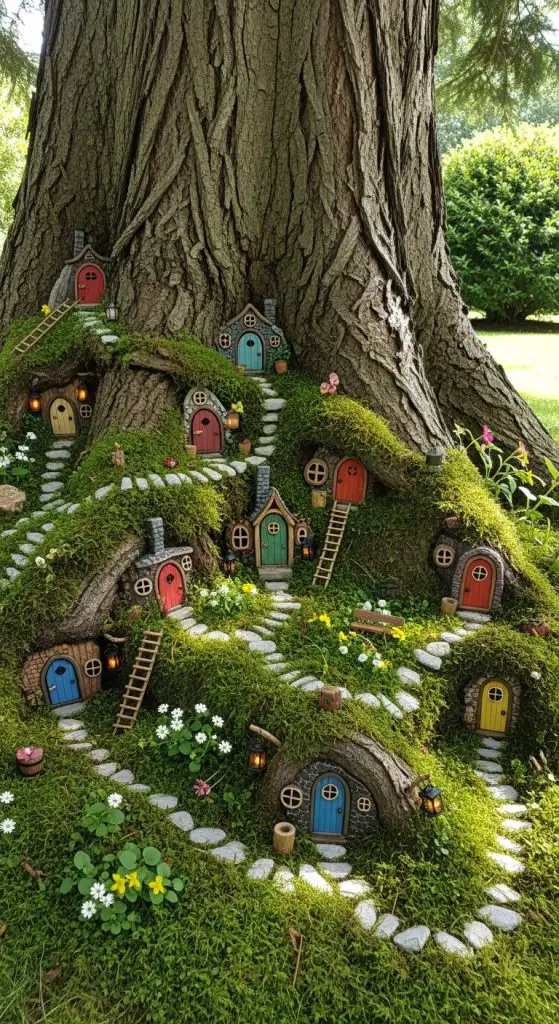
If you’ve got a tree in your yard, you’ve already got the perfect fairy real estate. Build a fairy garden around the tree base with moss carpets, tiny stone paths, and fairy doors on the trunk. It gives the illusion that fairies live right inside.
Kids especially love this style because it feels interactive. “Look, the fairies live in the tree!” is a phrase you’ll hear often if you’ve got little ones around.
Pros:
- Looks natural and magical.
- Makes good use of shady spots.
- Endless room for expansion.
Cons:
- Roots may interfere with planting.
- Harder to water evenly.
9. Fairy Garden in a Lantern
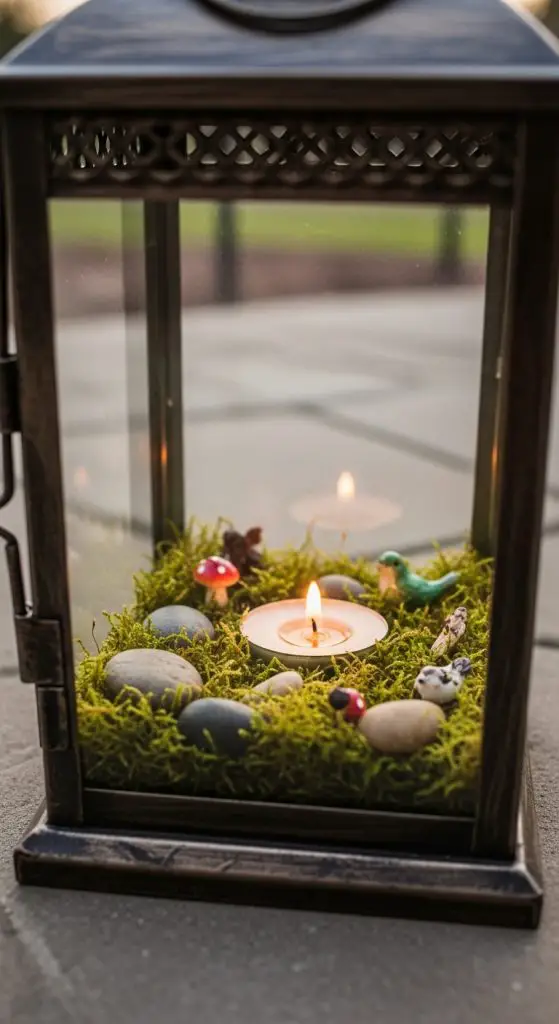
An old lantern can double as a miniature fairy terrarium. Remove the glass panes (or keep them for protection), fill the base with moss, pebbles, and miniatures, and voilà — a self-contained fairy world.
This works great indoors, especially for people in apartments. Add a battery-operated tea light, and you’ve got a fairy garden that glows at night.
Pros:
- Portable and decorative.
- Works indoors.
- Adds evening ambiance.
Cons:
- Very small space = fewer plants.
- Limited sunlight if indoors.
10. Fairy Garden in a Wheelbarrow
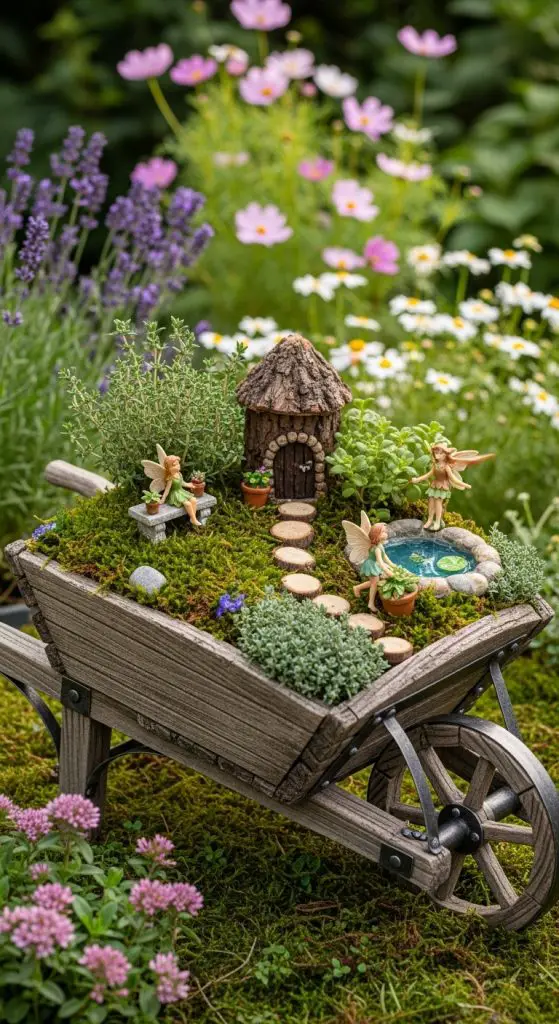
A rustic wheelbarrow makes for a fantastic mobile fairy garden. Similar to the wagon idea, but with more rustic charm. You can push it around the yard, or park it in a sunny corner as a magical display.
This style looks especially good in cottage gardens or rustic-themed landscapes.
Pros:
- Large surface area.
- Portable and adjustable.
- Rustic aesthetic fits cottage-style yards.
Cons:
- Heavy once filled.
- May rust or crack over time.
11. Fairy Garden with a Water Feature
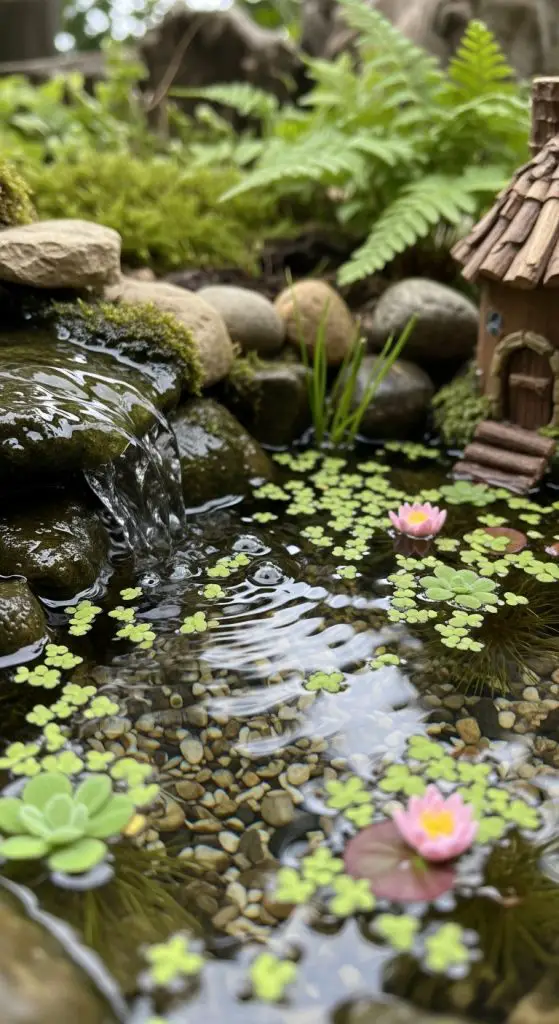
Why not give your fairies their own pond or waterfall? A fairy garden with a water feature can be as simple as a small dish of water with floating “lily pads” (a.k.a. succulent cuttings), or as elaborate as a mini fountain.
Adding water brings sound, reflection, and movement, which really ups the magic factor.
Pros:
- Adds relaxing sound and motion.
- Makes the setup feel more alive.
- Attracts real wildlife (butterflies, birds).
Cons:
- Higher maintenance.
- Standing water can attract mosquitoes.
12. Fairy Garden in a Broken Pot
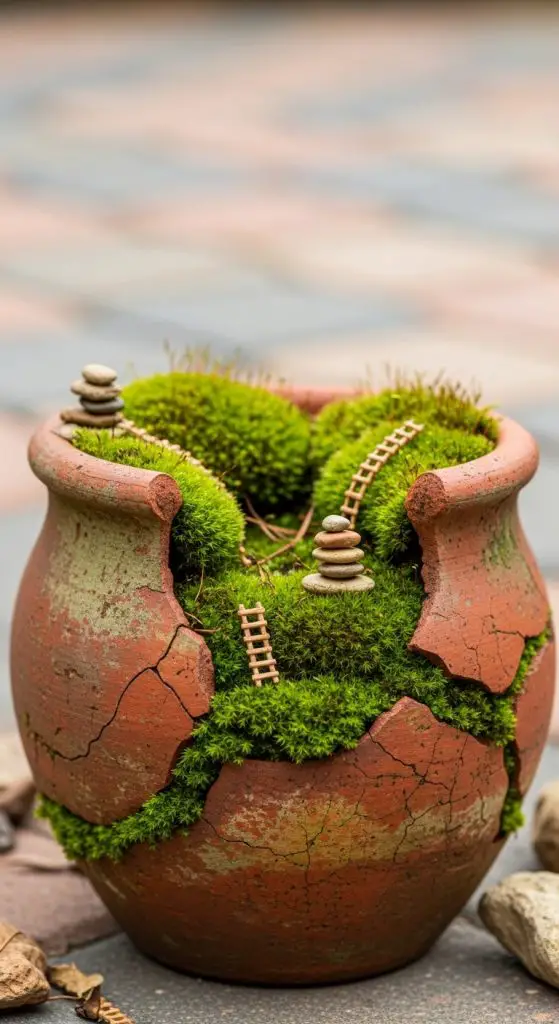
Instead of tossing that cracked terra cotta pot, turn it into a layered fairy garden. Use the broken edges as terraces, planting small succulents or moss on each level. Add a winding staircase or mini ladder, and it looks like a fairy condo complex.
Pinterest is full of these, and for good reason — they’re creative, affordable, and just plain cool-looking.
Pros:
- Upcycles broken items.
- Layered design = visual interest.
- Compact and space-saving.
Cons:
- Fragile and may continue breaking.
- Limited soil depth.
13. Fairy Garden in a Drawer
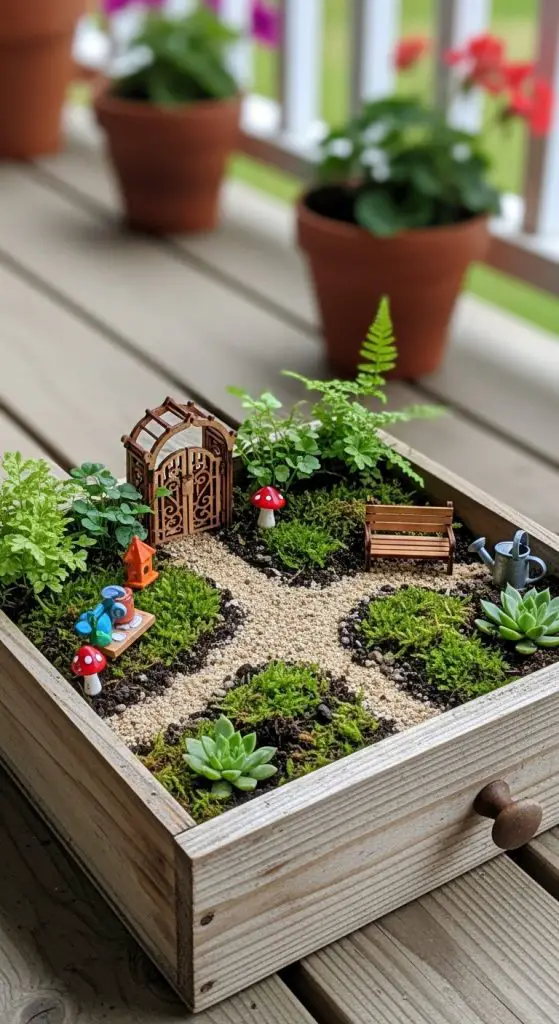
Got an old dresser drawer lying around? Repurpose it into a drawer fairy garden. The shallow, rectangular shape makes it easy to design neat pathways, fairy homes, and clusters of plants. Bonus: you can stack drawers for a tiered fairy village.
This style works great on porches or balconies since drawers are easy to move.
Pros:
- Great way to recycle furniture.
- Unique and eye-catching.
- Portable and versatile.
Cons:
- Wood may warp outdoors.
- Limited soil depth.
14. Fairy Garden with Seasonal Themes
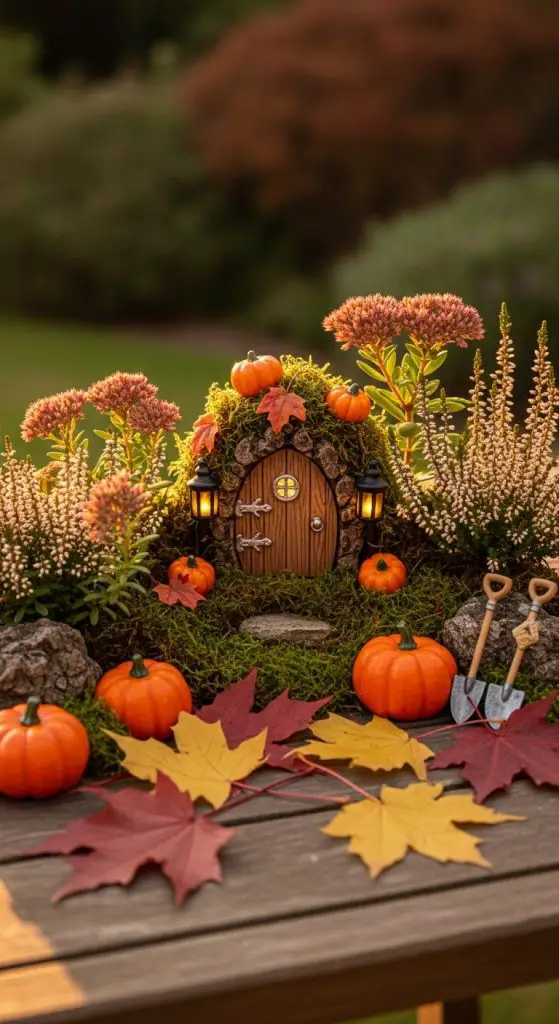
Why stop at one theme? Try seasonal fairy gardens that change throughout the year. Spring might feature pastel fairy houses and blooming flowers, summer could have a beachy vibe, fall brings pumpkins and leaves, and winter? Tiny fairy snowmen, of course.
This approach keeps things fresh and lets you have fun decorating multiple times a year.
Pros:
- Ever-changing, so it never gets boring.
- Perfect for holiday décor lovers.
- Encourages creativity year-round.
Cons:
- Requires regular updates.
- Can get pricey if you buy lots of seasonal props.
15. Fairy Garden in a Terrarium
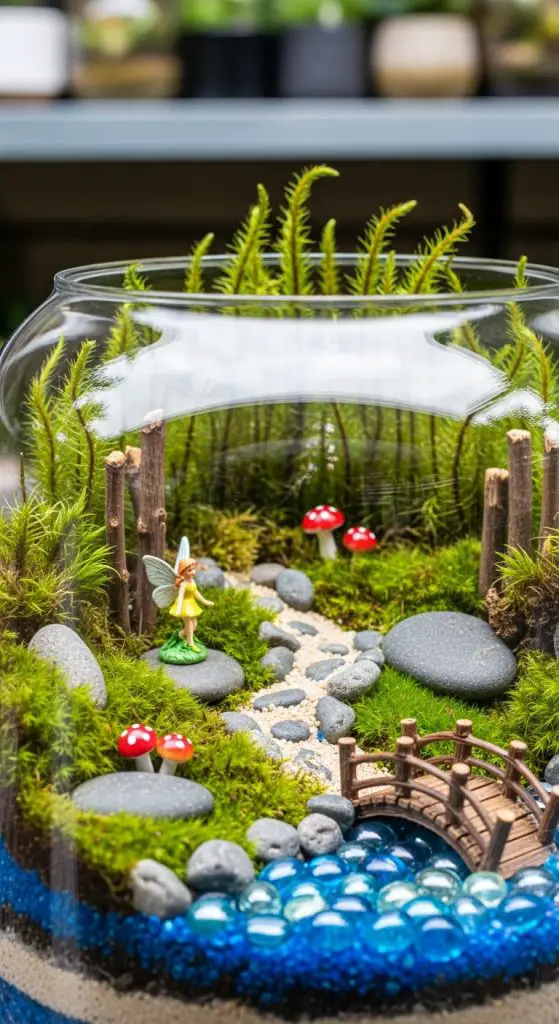
Last but not least, the fairy terrarium. Glass containers showcase the miniature world beautifully while protecting plants from dust and pets (looking at you, cat owners).
Terrariums can sit on coffee tables, shelves, or desks — giving you a fairy escape hatch at arm’s reach.
Pros:
- Great for indoors.
- Protects delicate plants.
- Stylish and modern.
Cons:
- Condensation can be an issue.
- Limited plant options indoors.
Conclusion
And there you have it — 15 enchanting fairy garden setups that prove magic really can exist in your backyard (or even your coffee table). From teacups to terrariums, wagons to tree stumps, there’s truly no limit to where fairies can “move in.”
If you ask me, the best fairy gardens aren’t the ones with the most accessories or fanciest plants. They’re the ones that make you stop, smile, and imagine tiny wings fluttering through the greenery.
So what are you waiting for? Grab that old teacup, drawer, or birdbath and start creating your own fairy haven today. Trust me — your garden will thank you, and your inner child will too. 🙂

William Martin is a passionate bowler who spends most of his weekends playing the sport. With years of intense experience under his belt, William decided to share his knowledge by creating BOWLING OCEAN. Join me on this journey to explore the world of bowling and discover the tips and tricks to becoming a pro.

